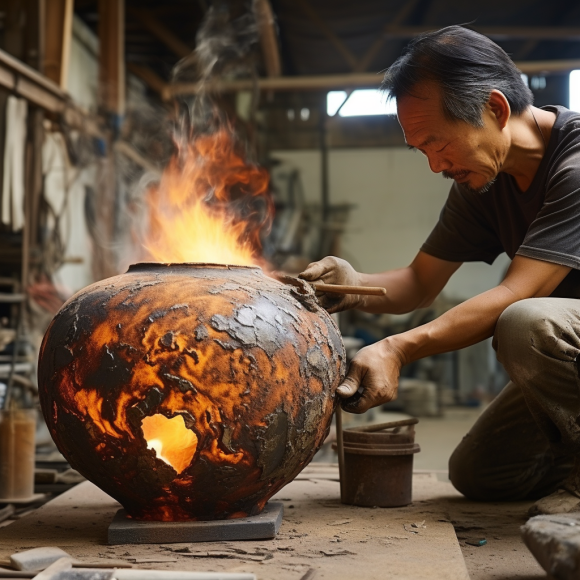Raku ceramics is a unique and revered firing technique that originated in Japan in the 16th century. In this blog post, we will explore the fascinating world of Raku ceramics, its rich history, and the distinct characteristics that make it a beloved and sought-after form of ceramic art.
- Introduction to Raku Ceramics: Raku ceramics is a firing technique known for its rapid firing and post-firing reduction. It involves removing red-hot pottery from the kiln and placing it into combustible materials, such as sawdust or leaves. This process results in dramatic and unpredictable surface effects, creating one-of-a-kind pieces with a distinctive aesthetic.
- Historical Significance: Raku ceramics has deep roots in Japanese history and culture. It was initially developed by the Raku family, who served as the preferred potters for the tea ceremony masters of the time. Raku ware was prized for its rustic simplicity and its ability to enhance the tea ceremony experience. Today, Raku ceramics continue to carry the spirit of tradition and reverence for nature.
- Raku Firing Process: The Raku firing process involves several key steps:
- Bisque Firing: The pottery is bisque-fired to remove moisture and achieve a stable form. This initial firing prepares the pieces for the subsequent Raku firing.
- Glazing: Once bisque-fired, the pottery is glazed using Raku-specific glazes. These glazes are often low-fire and formulated to produce unique colors and surface effects during the Raku firing process.
- Raku Firing: The glazed pottery is quickly fired in a small, portable kiln. The temperature rises rapidly, typically reaching around 1800°F (980°C) within a short period. At this point, the red-hot pottery is removed from the kiln using tongs and placed into combustible materials.
- Reduction: The pottery is covered with the combustible materials, which ignite and create a reduction atmosphere. This reduction process produces striking surface effects, including metallic lusters, crackles, and smoky patterns.
- Cooling and Cleaning: After the reduction process, the pottery is carefully cooled, often in water or with the aid of air. Once cooled, the pieces are cleaned to remove the remaining soot and debris, revealing the final surface characteristics.
- Surface Effects and Aesthetic: Raku ceramics are renowned for their unique surface effects and vibrant colors. The reduction process during firing creates crackles in the glaze, metallic lusters, and rich, earthy tones. The smoky patterns and unpredictable results are highly sought after by collectors and enthusiasts alike. Raku ceramics have a rustic and tactile quality that invites both visual and tactile exploration.
- Modern Interpretations: While traditional Raku techniques and aesthetics remain highly valued, modern ceramic artists have expanded the boundaries of Raku ceramics. They experiment with glaze compositions, firing methods, and alternative materials to create innovative interpretations of the technique. These contemporary Raku pieces showcase the versatility and adaptability of this ancient firing technique.
- The Zen of Raku: Raku ceramics are closely tied to Zen philosophy and the principles of mindfulness and presence. The process of Raku firing demands a deep connection with the present moment, embracing the imperfections and embracing the spontaneous results that emerge. The meditative qualities of Raku firing make it a spiritually rewarding and contemplative practice.
- Collecting and Displaying Raku Ceramics: Raku ceramics hold a special place in the hearts of collectors and art enthusiasts. The one-of-a-kind nature of Raku pieces makes them highly prized and cherished. When displaying Raku ceramics, consider the interplay between the pieces and their surroundings. The organic and rustic nature of Raku ceramics often harmonizes well with natural elements and minimalist settings.
Conclusion: Raku ceramics are a testament to the rich history and enduring beauty of Japanese pottery traditions. The firing technique, with its rapid firing, reduction process, and unpredictable results, creates ceramic pieces that are imbued with a sense of history and an appreciation for the beauty of imperfections. Whether it’s the crackles in the glaze, the metallic lusters, or the smoky patterns, Raku ceramics captivate and inspire, reminding us of the harmonious relationship between art, nature, and the present moment.
Embrace the art of Raku ceramics, explore its techniques and aesthetics, and let the spirit of tradition and mindfulness guide your creative journey. Experience the transformative power of Raku firing as you create unique and captivating ceramic pieces that carry the essence of this ancient and revered firing technique.



